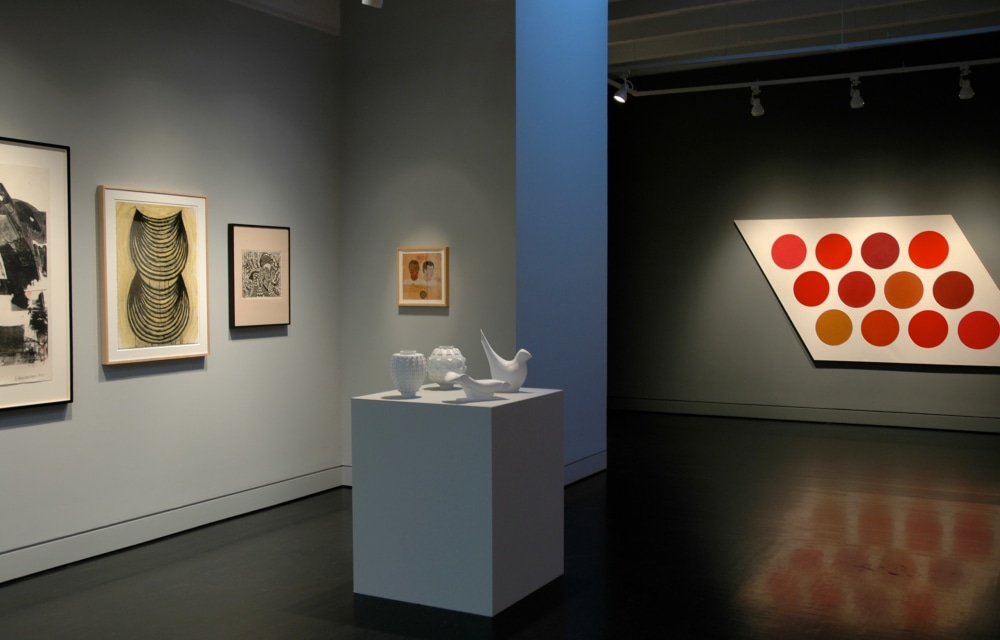
What, the gallerists have ESP or something?
The day comes for me to sign off - yep, this is my last Galleries column - and what do the dealers do? They trot out exhibitions looking suspiciously like stills from "Jessica Dawson: This Is Your Life."
Sam Gilliam! I never loved you enough. Now Hemphill has guilted me into reconsidering.
Simon Gouverneur! I never understood what the fuss was about. And I still don't.
Graham Caldwell! Still working in glass, but now breaking it intentionally . . .
And the list goes on. Whether a group, two-person or solo show, almost every exhibition in the city's top galleries stars artists I've reviewed once, twice or possibly many more times.
All this could mean one of three things: 1. The gallerists do indeed possess psychic abilities and planned their schedules accordingly. 2. It's January - the August of winter - and retreads are no-brainers when things get slow. 3. I've been doing this for a very long time.
The trip down memory lane begins at Irvine Contemporary's "Saturnalia." A fancy name for a standard-issue group show, "Saturnalia" collects seven gallery artists' latest efforts. If they're to be read, as director Martin Irvine suggested, as auguries of what's to come, put my money on the cliche of "the more things change."
Melissa Ichiuji, whose suggestive and masochistic sculptures of women made from pantyhose filled with fabric (and other stuff) intrigued me a few years back, returns with iterations on a theme. In her latest efforts, she's taken thrift-store tchotchkes - the schlockiest of bird and pig ceramics - and cocooned them in . . . stockings and fabric. Now the beasties have breasts and act as creepy and naughty as the girls do.
As for the others: The duo of Nicholas Kahn and Richard Selesnick are still producing neo-Bruegel, quasi-Jules Verne retro-futurist scenes presented in exaggerated horizontal formats. Teo Gonzalez is still working through his obsessive-compulsive issues by painting endless tiny dots on panels. Et cetera.
Newish to me, and interesting: Hedieh Javanshir Ilchi's pair of acrylic paintings on Mylar that mix Persian miniature painting traditions with contemporary themes playing against a backdrop of Western-style abstraction. I'll leave it to the next Galleries columnist to tackle her.
George Hemphill, our days of greeting with gritted teeth have ended.
George, I have to tell you, Hemphill Fine Art's "Viewing Rm." blew me away. I thought I'd be getting a slapdash no-brainer - the show aims "to share the back room experience with a larger audience" - yet this selection is as elegant and dynamic as they come.
Here hang big, striking works by Tom Downing and Jacob Kainen. Here, too, are precious works on paper by Al Jensen and Alma Thomas. That Eugene Atget picture of the taxidermist's vitrine? I'll take it.
But the exhibition's real star, benefiting from a particularly dramatic installation, is Sam Gilliam. The Washington Color School artist's "Flipping" is a pinwheel of stained canvas that buzzes like a butterfly. Produced in the early 1970s when Gilliam was making waves, it's a sure reminder of why Gilliam matters.
Over at Adamson Gallery, it's the Robert Longo show. Called "New Editions 2011," the current hang includes one print each by Iona Rozeal Brown and Chuck Close but otherwise belongs to eight massive Longo prints culled from his various series.
My fave-of-the-moment is the pair of Maui-size waves from Longo's series "Monsters." I'm particularly fond of "Untitled (Thunder Road)," a muscular barrel coiled like a spring. Delish.
Curator's Office serves up a pair of color-mad formalists: the late Simon Gouverneur, much beloved and exhibited by gallery director Andrea Pollan - she showed him when she was curator at McLean Project for the Arts and now manages his estate - and Andy Moon Wilson, whose recent abstract efforts are superior to his earlier, doodlelike works. As for Gouverneur, these two large mid-1980s canvases are groovy color studies but not much more.
Over on Florida Avenue NE, G Fine Art shows Graham Caldwell, a former Washingtonian now residing in Brooklyn who has been working with glass for much of his career. (Though once, memorably, he abandoned glass entirely in a rubber-and-metal installation at Addison/Ripley.) Now he offers curious wall-hung objects embedded with faceted bits of glass and mirror; they're shy and aggressive at the same time. A few pieces feature broken glass held together by anthropomorphic metal exoskeletons, a development I'm liking.
Leigh Conner and Jamie Smith at Conner Contemporary bring out a trio of works by digital video artist Brandon Morse; his atmospheric videos make the gallery feel like a tripped-out night club. Feel free to pass right through Cordy Ryman's obdurate objects in the front room (don't let those Day-Glo colors fool you; these unhappy wood constructions aren't glad to see you) and head straight to Morse's videos in back.
And finally, Industry. A newish venue for design, the gallery and I don't really have the history. Right now it's showing young Belgian-born Jens Praet, who shredded magazines and made benches, tables and shelves from them. After their round in the Cuisinart, those colorful magazines turned funereal shades of gray; Praet's somber objects can be read as comments on the state of print journalism today.
And what about me? I'm joining the staff of the Hirshhorn Museum and Sculpture Garden's new temporary event space, known as the Bubble, which is scheduled to open in October 2012.
Though champagne may be hoisted by those gladdened by my departure, it's with sadness that I bid adieu to Washington's galleries and The Washington Post. It's been a privilege. Thank you, all.